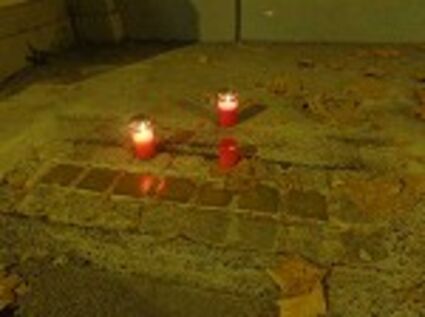Stumbling Stones
May 25, 2016

These plaques mark the location of a historic atrocity and list the names of the people who were hurt. Candles were placed there last Nov. 9 to mark the anniversary of the 1938 “Crystal Night” when Jews were attacked and their homes and businesses vandalized by the Nazis.
While most of the bigger cities in Germany and Austria have museums and monuments documenting the horrors of World War II and the Holocaust, there is one kind of smaller memorial that can be found in towns of all sizes in not just Germany and Austria, but most of the countries that were occupied by the Nazis during the 1930s and 40s.
Despite the prevalence of this particular memorial, it is something that you may miss if you’re not already aware of its existence. This is because it consists not of statues or monuments, but small gold plaques in the ground, lying side-by-side with the other cobblestones.
Stolpersteine, or Stumbling Stones, were the brainchild of artist Gunter Demnig and can be found in 20 countries throughout Europe, notably in Germany, Austria, Hungary, Poland, the Czech Republic, and the Netherlands — all countries which lost massive amounts of victims to the Holocaust.

The square brass plaques, smaller than an adult-sized hand, are found in front of properties that were once the homes and businesses of Holocaust victims. On each plaque is engraved the name of the victim, the persecuted group he or she belonged to — Jews, socialists, etc. — the date of deportation, which camp he or she was sent to, and if the person died during the Holocaust, it includes the date, manner, and location of death.
The idea behind the name Stumbling Stone is that the stones are the same size as the other cobblestones except for the fact that they’re a little raised, so you don’t notice them until you stumble over them. Once you stumble over them, you take a moment to pause and reflect on what went on at this spot over 70 years ago.
Stumbling stones can be found aplenty, not only throughout downtown Salzburg, but also throughout Bamberg, Bavaria, the city of my relatives.
I visited Bamberg again this past weekend and was surprised at how many stones I noticed there — perhaps new ones had been laid since the last time I visited. There are over 50,000 stones in Europe, and new locations are constantly being added to the list — Greece and Spain were added last year.
On the narrow medieval streets of central Salzburg, there are quite a few Jewish names, because many Jews were historically successful business owners. However, in the busy shopping street called the Getreidegasse, there are also two Jehova’s Witness stones.

Though stones honoring Jews are the most common, since they were the biggest single group murdered at the camps, there can also be found stones commemorating Jehova’s Witnesses, socialists, communists, homosexuals, those with disabilities, the Roma, and anyone who actively opposed the war, including the Resistance and Christians.
The first stone was laid in Cologne, Germany on December 16, 1992, the 50th anniversary of Heinrich Himmler signing the Auschwitz Decree.
There is a whole group of Stumbling Stones just down the street from where I live. The stones sit in front of what was once a business that was destroyed on Crystal Night.
All of the Jews living there were rounded up and sent away; none survived to return to Salzburg. This particular street is busy, lined with fashionable stores, and bordering the Mirabell Palace and Gardens, which is always bursting with “Sound of Music” tourists. It is not the kind of location one would expect to see a Holocaust memorial, but that is what I love about the Stumbling Stones.

They are a way of jolting us out of our busy lives and reminding us to be thankful for what we have, and to never forget the past, lest history repeat itself.




Reader Comments(0)